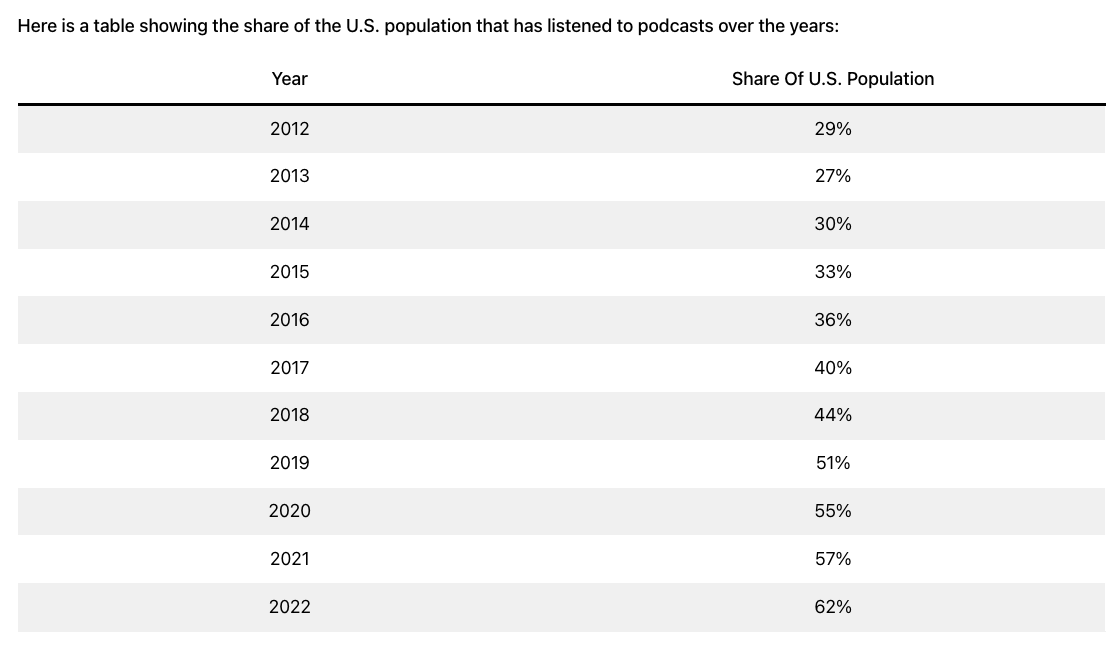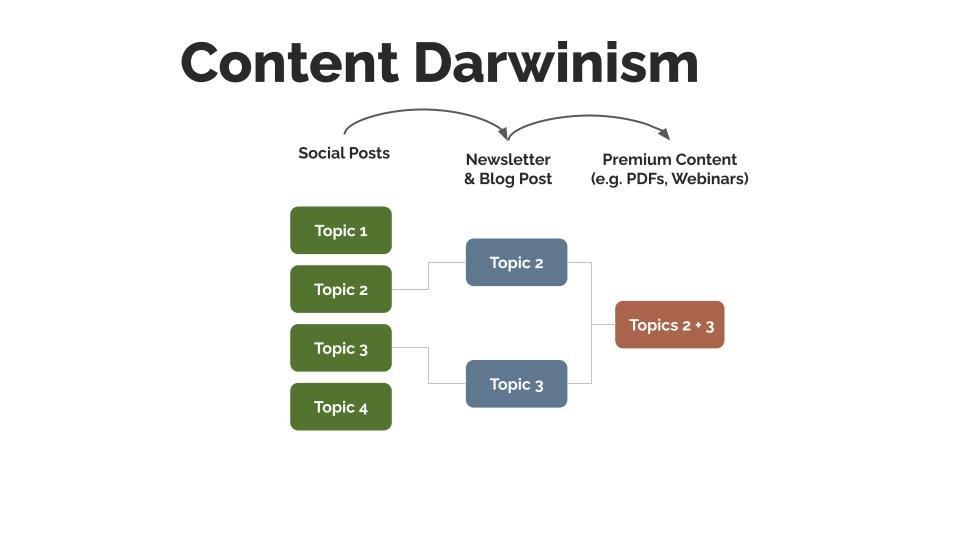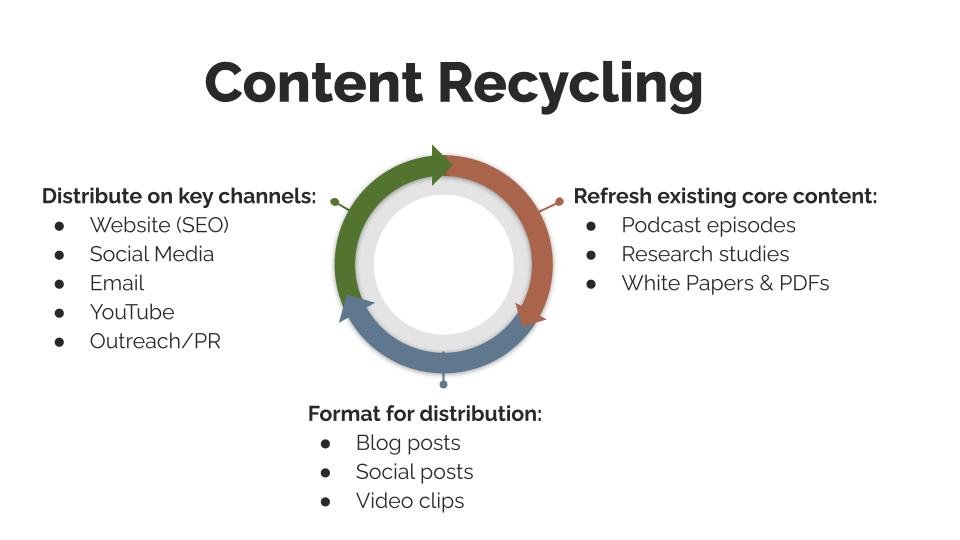7 Content Marketing Frameworks for Lead Generation
You know you need marketing content. It’s what fuels your digital strategy. But without the right framework, you could wind up frantically creating content, hoping it ranks in search results.
Instead, establish a process that works for your business and buyers. With the right content marketing framework, you can create content from a single source. Then, distribute it on various channels in different formats.
Recently, I talked through all of these frameworks on an episode of Breaking BizDev:
Content marketing frameworks accelerate the rate of thought leadership
Over my time working with B2B and professional service companies, I’ve encountered many different approaches to content marketing. There’s no right way to do it. You find a way that works based on your available resources and your target buyers.
A lot of companies get stuck when they create content, promote it once, then let it sit on a shelf and collect dust. It’s easy to get caught up in thinking about the next topic.
Unfortunately, this leads to a “spray and pray” approach of publishing content to see what sticks. It’s easy to get caught up in thinking of the next topic, you forget to devote resources to promoting existing content. (Believe me, I’ve been there, too.)
To make matters worse, key stakeholders like the CEO and CFO won’t likely see value in the content program because the IP hasn’t been used to its fullest potential. Or, they still don’t understand how it works.
Instead, develop a content marketing framework that fits your business and your buyers.
This helps two very important roles on your team:
A detailed version helps marketers, agencies, and individual practitioners visualize and execute the strategy
A simplified version helps non-marketers (e.g. key stakeholders) understand the strategy
Content Marketing Frameworks for Lead Generation
Selecting the right content marketing framework depends on your existing assets, creation processes, mediums, channels, and more. In many cases, your content operation may have elements of different frameworks in this article.
I broke down the frameworks into three different sections:
Frameworks for Creating Original Content
Frameworks for Curating External Content
Frameworks for Maximizing Existing Assets
This article will provide a brief overview of each. If you’re interested in developing a content marketing framework for your business, let’s chat.
Content Marketing Frameworks for Creating Original Content
Weekly Newsletter
Social media is like talking to someone at a frat party. Email is like talking to a friend over dinner. Weekly newsletters are a popular content marketing framework to keep an audience engaged until they're ready to buy.
But giving up an email address can be hard for users. Subscribing to a newsletter means they're inviting more noise to their inbox. First, you need to capture attention…
Step 1. Capture attention
Attract users on search and social. Make sure your content includes calls to action (CTAs) to convert a percent of users into email subscribers. Establish clear expectations:
What will they receive?
When will they receive it?
How frequently?
Step 2. Add native value
Consistently send valuable insights that can be consumed natively in the inbox. Links are good, but don't withhold value. Users trusted you with their email address. Deliver for them! Here are some different ways to add native value:
Curate examples
Share original research
Share personal stories
Step 3. Include conversion points in your newsletter
Include calls-to-action (CTAs) for users to take the next step, that could be:
An interactive product tour
Download a case study
Request a proposal
Purchase a course
A consultation
An audit
Step 4. Deepen engagement
As users become exposed to CTAs, but are not yet in a position to buy, you can deepen the relationship:
Engage with them on social media
Ask them to participate in surveys
Invite them on as podcast guests
Co-present in a webinar
Do raffles or giveaways
Host Twitter spaces
LinkedIn live
Step 5. Convert subscribers into paying customers
Email newsletters build trust with your subscribers. When they're ready to buy, they're already familiar with you and move faster through your sales pipeline.
Podcast Flywheel
There is possibly no better source for original content than a podcast. Yes, it enables your content and messages to be distributed across audio, video, and text-based channels. But not only that, it’s a way to inject personality into what might be perceived as an otherwise boring topic.
According to DemandSage, The United States has more podcast listeners than any other country. More than 60% of U.S. adults have listened to a podcast—a number that continues to grow year-over-year.
It’s not only true crime and entertainment podcasts that are being consumed. Your buyers are listening to podcasts, too.
Business podcasts are the 4th most consumed podcast category, after Society & Culture, Education, and Arts. LinkedIn conducted a survey that showed 44% of department heads, VPs, owners, and C-suites listen to podcasts.
There are many benefits of podcasting for businesses. Recently, I caught up with Allyson Cochran, Chief Revenue Officer at Silverback Strategies, a digital marketing agency in Washington, D.C. Between 2021 and 2022, I hosted 60+ episodes of the Digital Marketing Troop podcast while working directly with Allyson. In this video, Allyson talks about the benefits of podcasting to the agency, including sales enablement, deepening client relationships, strengthening the agency’s employer brand, and more.
Companies that have someone willing to be the face of the brand benefit the most from a podcast flywheel strategy. This approach optimizes the utility of content delivery, with transcripts used to produce written content, and video clips are used on YouTube and social media.
You don’t have to host a podcast to reap the benefits, either. If you have a core message you want to distribute on podcast channels, you might consider a podcast guesting strategy. This way you can access the existing audiences of established podcasts in your niche.
Original Research
In B2B and professional services, industry specialization matters to buyers. In fact, according to the Hinge Research Institute, industry knowledge was the top criteria buyers used to evaluate a professional service provider. So how can companies stand out while also demonstrating their industry expertise?
By using original research as content. Le't’s explore how this content marketing framework can be applied to a B2B or professional services firm.
The formula for original research as content is simple:
Interview and/or survey your target audience
Analyze the data and distill the insights
Publish the results and findings in a report
This not only demonstrates your understanding of the industry, but you can collect first-party data (email addresses) that fuels your marketing funnel.
Of course, creating original research is no walk in the park. For instance, choosing the right research method for your study can be daunting if you’ve never done research before. However, if you can pull it off you’ll have unique, differentiated content.
Published research is also a magnet for backlinks, which enhances your off-page SEO. It can be used as part of a digital PR strategy to pitch industry journalists and publications that accept guest articles. Webinars act as a vehicle to present research findings and answer audience questions.
If your business targets a specific industry or niche, an original research flywheel is a great content marketing framework. Here are a few companies that are currently using original research as part of their content strategy:
Winbound recently released their 2023 Research: How Manufacturers are Using Content report on how manufacturers are using digital marketing to generate leads and sales.
Helio is a continuous research platform that shares example surveys and test results on their blog. This article on needfinding showcases real examples of this kind of research in the wild.
Orbit Media Studios publishes an annual blogger survey that helps content marketers understand how their peers are creating content
Association for Accounting Marketing (AAM) releases a bi-annual marketing budget benchmark report of how accounting firms are allocating sales and marketing budgets
Content Marketing Frameworks for Curating External Content
Perhaps your strategy doesn’t have the resources to invest heavily into creating original content. Other content marketing frameworks can be used to curate existing ideas from influencers and other thought leaders. Here are a few:
Influencer Co-Creation
You don't have to create original content. Instead, reframe existing ideas and connect them to your product/service with our next content marketing framework: Influencer Co-Creation.
Influencer co-creation is when you take someone else’s idea, and re-frame it to help your product or service positioning. In doing so, you “borrow” an idea with social proof, giving you a better shot at resonance with your audience.
Some might call this a form of permissionless co-marketing, a term I first heard from Amanda Natividad. However, I believe this takes it a step further. The ultimate goal of this framework is to co-create content with someone who holds influence within your target market.
Here’s an example of how this content marketing framework can play out:
Social Media. Feature a relevant idea or framework in a social post and tag the original author.
Slack your tribe to give the post some engagement. Hopefully, the author will like the post and leave a comment/reply.
Blog. Expand upon the social post into a blog. Link to the author, give them credit, then connect the idea to your product/service. Circle back around to the original social post and drop a comment linking to the blog.
Recorded Media. Invite the author to co-create content on a podcast or live webinar together. Now, you have high-quality media to fuel your content strategy.
Content Darwinism
How do “creators” publish so much content?
It’s pretty simple, really: volume and throughput of ideas. In other words, if you get enough swings at the bat, you’re bound to get a hit.
Most creators use social media to test new topics and ideas. Then, when they find an idea is sticky, they’ll build around that topic. I call this framework Content Darwinism. This survival-of-the-fittest content marketing framework ensures only the strongest ideas survive and evolve.
The beauty of this framework is it’s fueled by social proof. This way, you can avoid sinking resources into creating PDFs and webinars that fall flat.
But it doesn’t have to only work for creators.
It can work for an individual expert as well as an established B2B or professional services brand. First, you need different sources for new ideas fuel a consistent social media posting cadence:
Gen AI
Employees
Customer interviews
Talk to your sales team
Industry thought leaders
Then, batch create your social posts and schedule them out. This helps you get over the fear of publishing. With consistent and intentional effort, your visibility will grow and you will begin to see patterns in the signals you get from your audience.
Feed the machine and learn faster.
Of course, you also need an audience big enough to discern signals of whether the content is resonating or not. Are you testing content topics on social media? If you need help, simply reach out.
Content Marketing Frameworks for Maximizing Existing Assets
Demand Capture Funnel
Perhaps more broadly known as the “marketing funnel,” or “inbound funnel,” I’ve seen it best used as a magnet to capture existing demand. Buyers have a need, they search to understand a particular problem and find helpful resources (content) that influence their decision. Then, they subscribe to an email list or follow the company on social media. When it’s time to buy, they know who they want to reach out to.
The marketing funnel is perhaps the most common content marketing framework of the last 10 years. Probably because it’s so simple and easy for executives to understand in theory. Content that is created has a purpose: to serve awareness, consideration, or purchase.
However, funnels can take time to build. AI may make it easier for startups and small businesses to race to the middle, but you’d need a process for producing content at that scale. On top of that, marketing funnels are most effective when users offer their email address in exchange for something valuable — an email newsletter, PDF download, or perhaps they subscribe to your company’s podcast.
Content Recycling
PSA: Marketers, don't forget to recycle your content ♻️
The average social media user spends two hours and 30 minutes on social media each day. So how many posts do they see each day? Let’s assume in a 10-minute span, social media users scroll past 10 posts to engage with 1. That would mean users scroll past 150 posts and engage with 15 each day. If you weren’t among the 15 posts your target buyer engaged with today, were you at least visible among the 150?
Here are the steps you can take to incorporate this content marketing framework:
Step 1: Refresh existing core content
Make sure your core content is up to date. This could be a content update, a design refresh, or both!
Podcast episodes
Research studies / PDFs
Webinars
Step 2: Format for distribution
Take your core content and use it to give each channel native fuel:
Email
Blog post
Social posts
Slack messages
Short video clips for social
Long video clips for YouTube
Step 3: Distribute on key channels
Set up repeatable workflows. Technology is great, but ultimately it’s human operators that make content distribution effective. Here are some key channels to consider in your content distribution:
Website (SEO)
Email
YouTube
Social media
Digital PR / outreach
Podcast platforms
Communities/association groups
Events/tradeshows
Companies that have invested in content in the past have an opportunity to “recycle” existing content into promotion cycles. This way, companies maximize the value of their marketing content and core, evergreen messages are distributed to target buyers efficiently.
Select the Right Content Marketing Framework
The right content marketing framework depends on your existing content, processes, mediums, channels, and more. It must also take into account your goals and objectives for the business. Reach out if you need help selecting the right content marketing framework for your B2B or professional services firm. If you were to visualize your own content marketing framework, what would that look like?








